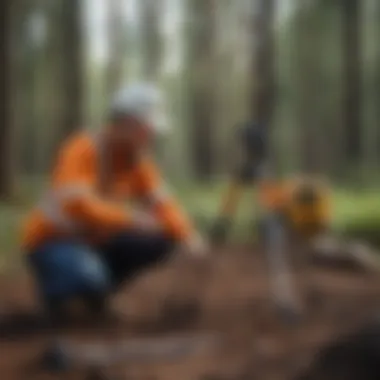Comprehensive Guide to Land Survey Costs per Acre


Intro
This article aims to dissect the multitude of factors influencing these costs. From methodologies utilized to the various types of land surveys available, we will cover essential elements that impact pricing."
Market Overview
Current Market Trends
Land surveying has seen shifts due to increasing land values and development activities. As urban expansion continues, the demand for precise land surveying services has risen. Clients now expect detailed data that can only be provided through advanced survey techniques.
Economic Indicators Impacting the Market
Factors like interest rates and inflation influence land survey costs. Low interest rates can lead to increased property investments, thus heightening demand for surveying. On the other hand, inflation can cause expenses in equipment and labor to rise, affecting overall prices.
Global Influences and Major Events
Global trends such as climate change also impact the need for land surveys. For instance, natural disasters prompt reevaluations of property lines and conditions. Recent shifts in regulations can also affect surveying practices, with some regions adopting stricter guidelines that require more comprehensive surveys.
Types of Land Surveys
Understanding the different types of land surveys is essential when considering costs. These may include:
- Boundary Surveys: Define the precise lines of a property.
- Topographic Surveys: Detail the land's physical features, including elevation.
- ALTA/NSPS Surveys: Comprehensive surveys often required for commercial properties.
- Construction Surveys: Assist in establishing site layouts before building begins.
Each type varies in complexity and consequently in cost.
Regional Variations
Geographical location plays a significant role in surveying costs. Urban areas typically incur higher costs due to competition and demand for services. Conversely, rural locations may experience lower fees but could face limitations in service availability.
Understanding these regional differences will help stakeholders estimate costs accurately.
Culmination
In summary, the cost of land surveys per acre is dictated by several intertwined factors. By grasping the dynamics of market trends, economic indicators, and regional variations, clients can navigate the surveying landscape with greater confidence. This insight can lead to better budgeting and more informed decisions in real estate ventures.
Prologue to Land Surveying
Land surveying plays a critical role in real estate and land development sectors. It provides essential information about property boundaries, elevations, and topography. As such, understanding the principles of land surveying is necessary for individuals and organizations looking to make informed decisions regarding property transactions and development plans. This article aims to dissect various aspects of land survey costs, showing how they relate to this field.
Definition of Land Surveying
Land surveying is the science of measuring distances, angles, and elevations on the earth’s surface. It involves the establishment of property boundaries and the mapping of land features, which is fundamental for construction, zoning, and property taxation purposes. Surveyors use specialized equipment to collect accurate data that reflects the physical and legal state of the land.
Importance of Land Surveys
Land surveys hold significant importance across various dimensions:
- Legal Clarity: They clarify property boundaries, thus preventing disputes between neighbors and aiding in legal compliance.
- Development Planning: Surveys are crucial in the planning stages of construction projects, ensuring that buildings comply with local regulations and land use plans.
- Financial Implications: Understanding survey costs and their breakdown can influence budgeting for real estate investments.
- Enhancing Value: Accurate surveys can provide essential data that help maximize a property's value, especially when it is planned for development or sale.
Effective land surveying not only defines property lines but also shapes the future of real estate development and investment opportunities.
Overall, comprehending land surveying is key to navigating the complexities of buying, selling, or developing land. By understanding the costs associated with these surveys, stakeholders can make educated choices that align with their financial and strategic goals.
Factors Affecting Survey Costs
Understanding the costs associated with land surveys is crucial for anyone looking to engage in real estate transactions or land development. Numerous factors influence these costs per acre. By examining each element, buyers, sellers, and investors can anticipate expenses more effectively and make informed financial decisions.
Type of Survey
The type of survey required can significantly impact costs. Different surveys serve distinct purposes and require varying levels of expertise and equipment. For instance, a boundary survey primarily focuses on determining property lines and is typically less complex than an ALTA/NSPS land title survey, which includes detailed information regarding property boundaries, easements, and improvements. The more specialized the survey, the higher the costs may be due to the additional resources needed.
Size of Property


The size of the property also influences the overall survey costs. Larger parcels generally require more time and effort, which translates to increased labor costs. For instance, surveying a 50-acre property will likely take longer than surveying a small lot of one acre. Additionally, larger properties may have more boundary lines or complicated features that require closer examination, further adding to the expense.
Location and Accessibility
Location plays a key role in determining survey costs. Properties situated in urban areas often present different challenges compared to those in rural settings. Urban locations may have more buildings or utilities to navigate around, requiring more planning and additional work. Conversely, rural properties might be less complicated in terms of physical access but could have their own logistical issues. Accessibility to the site can also affect transportation and mobilization costs for surveying equipment and personnel.
Terrain and Topography
The terrain and topography of a property can impact how surveys are conducted. Steep inclines, rocky surfaces, or dense vegetation can complicate the surveying process and require more time and specialized equipment. For example, surveying a heavily wooded area may necessitate additional clearing, which adds to labor costs. Flat, open areas usually have lower survey costs due to easier access and less required maneuvering.
Existing Property Lines
Finally, existing property lines can affect the survey expenses. If property lines are well-documented and easily traceable, the survey process is smoother and generally less costly. However, if property lines are disputed or unclear, extensive research and cross-referencing of historical documents may be needed. This can extend the time needed for the survey and therefore increase costs.
Understanding these factors allows individuals and organizations to estimate potential expenses and budget accordingly for land surveys.
Types of Land Surveys
Land surveys play a crucial role in understanding property boundaries, assessing land characteristics, and informing land development projects. Each type of survey serves a different purpose and comes with its own cost implications. Knowledge of the various types of land surveys helps individuals and organizations make informed decisions, thus avoiding costly mistakes. Recognizing specific needs determines the best survey type. In this section, we will explore four primary survey types: boundary surveys, topographic surveys, ALTA/NSPS land title surveys, and construction surveys.
Boundary Surveys
Boundary surveys are essential for establishing and confirming the exact boundaries of a property. These surveys help property owners understand their legal land limits, which can prevent disputes with neighbors. Surveyors use various tools and techniques, including historical records and GPS technology, to mark the corners and lines of a property.
The cost of boundary surveys can vary based on several factors:
- Property size
- Survey complexity
- Location
In metropolitan areas, boundary surveys might be more expensive than in rural locations. Also, the presence of conflicting claims or unclear boundaries can inflate costs. Thus, clarity in the survey type leads to an accurate budget estimate.
Topographic Surveys
Topographic surveys focus on the physical features of a land parcel, mapping elevations, depressions, and existing structures. This type of survey is invaluable for developers, architects, and engineers, as it provides the necessary information to plan construction and design projects. The surveys are typically detailed and may include contours, drainage patterns, and vegetation layouts.
Topographic survey costs are influenced by:
- Site accessibility
- Survey detail required
- Terrain complexity
For instance, steep or heavily wooded terrain can increase the time and resources needed, that in turn raises the overall cost. Ultimately, investing in a topographic survey minimizes risks by ensuring accurate planning and development.
ALTA/NSPS Land Title Surveys
ALTA/NSPS land title surveys go further than standard boundary surveys by incorporating detailed property boundaries and identifying easements or encroachments. These surveys adhere to the standards set by the American Land Title Association and the National Society of Professional Surveyors.
They're particularly important for buyers and lenders involved in real estate transactions as they require a high level of accuracy and detail. The costs for ALTA/NSPS surveys can be higher because of the comprehensive nature of the process, which often requires more time and specialized equipment. Factors influencing cost include:
- Property size
- Location
- Specific lender requirements
Buyers can save time and money by understanding these details before engaging surveyors, thus ensuring they select the right type of survey.
Construction Surveys
Construction surveys are designed to help guide a construction project. They set out reference points for the layout of buildings, roads, and other structures. This type of survey is critical during the construction phase to ensure that the project adheres to the specified design and meets regulatory requirements.
Costs associated with construction surveys can vary widely due to:
- Project scale
- Complexity of the design
- Clarity of initial plans
Construction surveys ensure efficiency and compliance with local regulations, which ultimately saves money in potential rework.
By grasping the types of land surveys and understanding their importance, stakeholders can make educated choices that align with their goals and budget.
Regional Variations in Survey Costs


Understanding regional variations in survey costs is crucial for anyone involved in land transactions, whether it be individual investors, finance enthusiasts, or professional traders. The cost of a land survey does not follow a universal standard; it fluctuates significantly based on geographical differences. Numerous factors contribute to this variability, including differences in local economies, population density, and regulations. Being aware of these elements can greatly influence budgeting and decision-making processes.
Urban vs.
Rural Costs
Survey costs in urban areas often surge compared to those found in rural settings. In densely populated cities, higher demand for land often results in increased competition among surveyors. Additionally, complexities such as navigating through existing infrastructure and traffic contribute to elevated pricing. Urban surveys may demand more intricate planning and time, which reflects on the overall cost.
Contrastingly, rural areas tend to offer more straightforward surveying opportunities. Land has fewer obstructions, which typically leads to lower survey costs. However, this may not always be the case; some rural locations might incur additional costs due to their remote nature, resulting in higher transportation expenses for surveyors.
State Regulations and Fees
State regulations play a pivotal role in shaping survey costs. Every state has distinct laws governing land surveying practices, including specific licensing requirements for surveyors. Such regulations can impose additional fees that might not be visible initially. Understanding these nuances can prepare individuals for unexpected expenses, creating a realistic budget. Moreover, certain states may require more extensive documentation and awakening surveys for compliance, contributing to added costs.
Local Market Rates
Market rates in specific locations can greatly impact the pricing of land surveys. These rates vary based on prevailing economic conditions, the number of active surveyors in the area, and the level of demand for surveying services. In regions with abundant surveyor competition, prices might be more competitive; conversely, in less populated areas, fewer options can lead to elevated costs. Recognizing local pricing trends is essential for anyone seeking to engage a surveying service.
In summary, recognizing these regional variations in survey costs provides critical insight for effective budgeting and decision-making, whether in urban or rural settings. By examining factors such as urban vs. rural costs, state regulations, and local market rates, individuals can create informed strategies about engaging surveying services.
Typical Costs and Price Ranges
Understanding typical costs and price ranges for land surveys is crucial for anyone considering such services. It helps potential clients gauge what to expect financially and prepares them for budgeting. Knowing these costs aids in making informed decisions during real estate transactions or land development processes. Furthermore, contrasting prices across different types of surveys provides insight into the necessary investment required for specific needs.
Average Cost Per Acre
The average cost per acre for land surveying can fluctuate significantly based on several factors. Generally, it ranges from $300 to $1,000 or more, depending on the survey's complexity and location. This price is influenced by the size of the property, survey type, and local market conditions. For example, large tracts of land might cost less per acre compared to smaller, intricate properties due to economies of scale. Therefore, understanding this cost is integral for effective financial planning.
Cost Breakdown by Survey Type
Different types of land surveys come with varying price tags. Here's a breakdown:
- Boundary Surveys: These typically range from $500 to $1,200. They are essential for determining property lines.
- Topographic Surveys: Costs usually lie between $1,200 and $2,000. They detail the land's surface, essential for construction projects.
- ALTA/NSPS Land Title Surveys: These are more specialized and could cost between $2,000 and $5,000. They require adherence to exact standards, thus raising the cost.
- Construction Surveys: Prices vary widely based on the project's scale, generally between $1,000 to $3,000.
Each type serves a unique purpose, and understanding these costs helps clients decide which survey best suits their needs and budget constraints.
Additional Fees and Expenses
Additional fees can impact the overall cost of land surveying. Common extras might include:
- Travel Costs: If the site is remote, surveyors might charge extra for travel time or expenses.
- Permitting Fees: Depending on local regulations, securing permits can add to the total.
- Revisions: If clients make significant changes to the project after the initial survey, additional fees for revisions might occur.
- Technology Costs: Specialized equipment, such as drones or advanced software, may also increase expenses.
It's important for clients to discuss these potential additional costs upfront with their surveyor to avoid surprises later on.
Understanding these costs ensures a clearer budget and aids in choosing the right surveying service for your needs.
Engaging a Professional Surveyor
Engaging a professional surveyor is crucial for anyone looking to invest in land or undertake real estate development. The expertise and skill of a qualified surveyor can greatly influence the precision and reliability of the survey results. Some landowners may underestimate the complexities involved in this process. However, the implications of choosing a competent surveyor are significant, extending beyond mere cost considerations.
A professional surveyor brings a level of technical knowledge that ensures compliance with local laws, standards, and regulations. This is vital not just for initial assessments but also for future developments or potential disputes over boundaries. When surveying is done properly, it helps enhance clarity regarding property lines and minimizes the chances for legal issues down the line. Additionally, when working with a surveyor, one can receive insights about the property's geographical attributes that may not be immediately apparent.
In this section, we delve into specific aspects of the selection process and what potential clients need to keep in mind.
Choosing the Right Surveyor
Finding the right surveyor requires careful consideration. Several factors come into play when making this choice:
- Experience: Look for a surveyor with a proven track record in similar types of surveys. A specialist in boundary surveys will differ from someone experienced in topographic surveys.
- Licensing and Credentials: Ensure that the surveyor has the necessary certifications and follows local regulations. This helps in validating their professional capability.
- References: Seek recommendations from prior clients, as this provides a sense of the surveyor's reliability and the quality of their work.
- Technology Utilization: Check if the surveyor utilizes up-to-date equipment and software. Modern tools contribute to improved accuracy and efficiency.
Keep in mind that the initial impression and communication style of the surveyor also matter. A surveyor should be able to explain technical concepts in a comprehensible way and address any questions or concerns.
Initial Consultations and Quotes


The initial consultation with a surveyor is a vital step that sets the stage for the entire surveying process. During this phase, several key elements should be addressed:
- Scope of the Project: Clearly outline your goals and expectations for the survey. This can include the specifics of the land, what type of survey is needed, and any timeline considerations.
- Quote Estimates: After discussing your needs, the surveyor should provide a detailed estimate. This should itemize different costs involved, allowing you to understand where funds will be allocated.
- Discussion of Fees: Some surveyors might charge a flat rate, while others might use hourly rates or fees based on acreage. Ensure you are clear about their pricing structure to avoid unexpected costs later.
"Understanding the fee structure in detail is often overlooked but can prevent disputes later in the process."
- Written Agreement: Once you've received a quote you are comfortable with, ask for a written agreement. This provides a legal framework and sets clear expectations for both parties.
Budgeting for a Land Survey
Budgeting for a land survey is a critical aspect of real estate transactions and land development. Understanding the costs associated with land surveying can prevent unexpected financial burdens. This section explores essential elements and considerations in budgeting for a land survey, offering a clear framework for planning.
Estimating Costs
Estimating costs for a land survey requires careful analysis of various factors. The price can vary significantly based on the type of survey, the size of the property, and the geographic location. For example, a boundary survey will usually cost less than an ALTA/NSPS land title survey. Here are key elements influencing cost estimation:
- Type of Survey: Different surveys come with distinct costs. Analyzing what factor will result in a more accurate budget.
- Size of Property: Larger properties often have higher survey costs due to increased time and resources required.
- Terrain and Accessibility: If the land is hard to access or has challenging terrain, survey costs may increase.
To get the most accurate estimate, consider reaching out to multiple surveyors. They can provide quotes based on their experience and the requirements of your property. This practice ensures that you can make an informed decision that aligns with your budget.
Financing Options
Financing a land survey can seem daunting, but several options exist for those needing assistance. It is crucial to evaluate the available routes for securing funds. Here are some potential financing options:
- Personal Savings: Using your savings enables direct payment without interest fees or delay.
- Home Equity Loans: If you own property, tapping into your home equity can be a viable option to fund a survey.
- Rural Development Loans: Certain programs may offer financial aid for land buyers looking to develop property in rural areas.
Before proceeding, assess each option's long-term implications and ensure it fits into your overall financial plan.
“Proper budgeting for land surveys is not just about costs; it’s also about understanding the value it brings to your investment.”
Securing the right survey is paramount to ensure due diligence, prevent disputes, and maximize property value. By taking the time to budget effectively, one can navigate the complexities associated with land surveying and achieve satisfactory outcomes in their property endeavors.
Legal Considerations
Legal considerations play a crucial role in the realm of land surveying. Understanding the legalities surrounding property rights helps landowners and investors navigate complex regulations. This awareness minimizes risks and ensures compliance with local laws.
Understanding Property Rights
Property rights refer to the legal ownership and use of land. When engaging in land surveying, clarity regarding these rights is essential. Knowing the boundaries of your land prevents disputes with neighbors. It also ensures that the survey adheres to any local zoning laws, easements, or restrictions.
Key elements of property rights include:
- Ownership: Establishes who possesses the land and has the right to use it.
- Boundaries: Defines the limits of ownership and can impact property value.
- Easements: These are rights granted to others to use part of your land for a specific purpose.
A thorough understanding of these components assists in making informed decisions about land use.
Impact on Property Sales and Development
The implications of land survey results are significant for property sales and development. A detailed and accurate survey can enhance property value. Conversely, inaccuracies can lead to legal disputes which may derail transactions.
When buyers evaluate a property, the survey provides crucial data for the transaction. It can reveal:
- Encroachments: Unintentional overstepping of boundaries by neighboring properties.
- Property Lines: Clearly marked boundaries ensure potential buyers understand exactly what they are acquiring.
- Development Potential: Investors can gauge if the property meets local development regulations through survey insights.
Land surveyors’ reports are also often required during financing processes. Lenders need assurance of the property’s value and legal standing before approving loans. Thus, ensuring all legal aspects are addressed minimizes future complications and promotes smoother sales transactions.
Understanding property rights is vital in making confident investments in land.
Closure
Key Takeaways
- Diverse Costs: Land survey costs vary significantly based on factors like survey type, property size, location, and terrain. Recognizing these elements can lead to more accurate budgeting.
- Professional Guidance: Engaging with experienced surveyors ensures that land surveys are done correctly and efficiently. This can assist in avoiding unexpected costs later in property transactions.
- Legal Insights: Comprehension of legal considerations can impact property rights and future developments. Such knowledge minimizes risks during real estate negotiations.
Future Trends in Land Surveying Costs
The landscape of land surveying is continually evolving. Several trends are shaping how costs are determined and assessed:
- Technology Integration: Advances in technology, like drones and GPS, may reduce costs by streamlining the surveying process, minimizing the time required for data gathering and analysis.
- Regulatory Changes: Anticipating future changes in state and local regulations is essential. New laws can introduce additional costs or adjust existing fees.
- Demand Fluctuations: With the growth in urban development and property investment, the demand for land survey services will likely increase, which may influence pricing structures in the near term.
In summary, understanding the complexities of land survey costs per acre equips stakeholders with valuable insights. It enhances decision-making in budgeting and property investments, ensuring a smoother transaction process in the competitive real estate market.



